The best computer speakers
Mackie, Audioengine and Klipsch have you covered.

By Daniel Varghese and John Higgins
This post was done in partnership with Wirecutter. When readers choose to buy Wirecutter's independently chosen editorial picks, Wirecutter and Engadget may earn affiliate commission. Read the full guide to computer speakers.
If you listen to music, watch movies, or play games through your desktop or laptop computer, you could use a good set of computer speakers. Our favorite pair is the Mackie CR4BT set, which sounds great and is simple to set up and use. Plus, these speakers won't take up too much space on your desk and they pair easily with your mobile devices via Bluetooth.
We recommend the Mackie CR4BT computer speakers because they deliver a full, balanced sound, whether you're listening to bass-heavy rap music, ambient soundscapes, or conference calls. Intuitive design choices—like placing the volume wheel on the front and allowing either the left or right speaker to connect to the power source—make this system easy to set up and use throughout your day. Though the speakers are a bit larger than others we tested, they're still small enough that they won't take over your desktop. We aren't crazy about the neon green accents on the speaker's face, though; we would prefer different color options.
If you're willing to compromise a bit on sound quality and connection options to save money, consider the Mackie CR3 set. It has most of the same convenient features and design elements as the Mackie CR4BT but in a smaller form with a smaller woofer—which means the speakers can't play quite as loud or as deep as the CR4BT. The CR3 also lacks Bluetooth, so it doesn't connect as easily to your mobile devices. Still, these are by far the best-sounding computer speakers we've tested in this price range and a significant upgrade for anyone who has been using their computer's built-in speakers.
For the music lover who demands better audio quality—and is willing to pay more to get it—the Audioengine HD3 set is the closest thing we've found to a perfect set of computer speakers. It has substantially better sound quality and a smaller, more elegant design than the Mackie CR4BT. Plus the HD3 has a more comprehensive connection panel, with both analog and USB inputs and a subwoofer output for people who want to add a subwoofer. Bluetooth with aptX HD is also built in. However, the HD3 costs twice as much as the CR4BT.
If you watch a lot of movies or play cinematic video games at your desk, you might prefer a computer speaker system that includes a subwoofer to reproduce deep bass notes. Of all of the 2.1-channel systems we tested, the Klipsch ProMedia 2.1 THX set had the best sound quality, about as full and balanced as the Mackie CR4BT but with more potential bass response. Dialogue and acoustic instruments sounded clear and crisp, and the subwoofer effectively filled in the low end. The speakers have a very small on-desk footprint and sport a subdued but stylish design, but the connection options are limited.
Why you should trust us
Daniel Varghese is a Wirecutter associate staff writer who covers the AV and smart-home categories. He has used many speaker systems as a musician, podcast producer, and college radio DJ. John Higgins, who worked on the previous iteration of this guide, writes about AV for several outlets and works as a freelance film sound editor and composer in Los Angeles.
Who should get these
Powered computer speakers are a great option for anyone who enjoys listening to music, watching movies, or playing video games through their computer. If you've relied on the speakers built into your laptop or monitor, you've probably noticed that the sound is thin and tinny, with little to no bass. That's because the small speakers that fit in your laptop can produce only a portion of the frequency band that humans can hear. They tend to bottom out around 250 hertz, whereas humans can hear down to around 20 hertz and feel even lower than that.
The two-way woofer/tweeter design of most computer speakers will increase the sonic fidelity of anything you listen to, allowing you to hear parts of songs that you would otherwise miss from a pair of laptop speakers. For example, a kick drum that sounds like a dull clap out of laptop speakers will sound more like the full-bodied thump you'd expect to hear at a concert when played through a good pair of computer speakers. If you want even more bass to handle the lowest frequencies in music, movies, and games, you can add a separate subwoofer.
Wireless powered bookshelf speakers or passive bookshelf speakers can also achieve this, but they tend to be too big to sit on a desk. Our picks in this guide have a relatively low footprint, so they won't look ridiculous next to your laptop or monitor.
How we picked and tested

Computer speakers vary drastically in terms of size, price, and options. We used the following criteria to decide which computer speakers to test and how to evaluate their quality.
Sound quality: The biggest distinguishing factor between these speakers is their sound quality. We wanted to find speakers that have a balanced sound that will make everything from music to conference calls pleasant to listen to. We also made sure that they could play loud enough to hear from across a room.
User-friendliness: We preferred speakers with volume controls located on the front so that you don't have to reach around the back or rummage for a loose remote just to turn down your music while sitting at your desk. We also preferred models with multiple connection options.
Wireless connectivity: Since these speakers will likely remain connected to a computer through the workday, we don't think that built-in Bluetooth or Wi-Fi is mandatory. But we did appreciate the inclusion of this feature, as it makes the speakers easier to use with more sources, in more situations.
Form factor: We tested both 2.0 systems, which have only a left and right speaker meant to sit on your desk, and 2.1 systems, which include an additional subwoofer that goes underneath your desk. We looked for computer speakers that strike a good balance between size and performance. If the speakers are too small, they'll sound thin and lack dynamics. Larger speakers might sound louder and fuller but they aren't practical to have sitting on your desk. Have you tried working around a large set of bookshelf speakers? Where would you keep all of your knickknacks?
With these criteria in mind, we looked through all of the available models on sites like Amazon and Best Buy. We cross-referenced those with existing editorial reviews of speakers from audio experts like Steve Guttenberg at CNET and the writers at Sound & Vision, and roundups by other outlets like The Strategist. We culled this list further with input from Wirecutter's other audio experts and ended up with 12 systems to test for this update, including our existing picks (the Mackie CR3, Mackie CR4BT, and the Edifier R2000DB) and several new options (Audioengine HD3, Bose Companion 2 Series III, Creative Pebble, Creative Sound BlasterX Kratos S3, Creative Sound BlasterX Kratos S5, Edifier R980T, Edifier R1700BT, Harmon Kardon Soundsticks III, and Klipsch ProMedia 2.1 THX).
Before conducting blind listening tests, we broke in each system with music and video content. Daniel then listened to each system individually, determining its max volume and getting an initial impression of its audio quality. This allowed him to quickly dismiss several speakers that sounded compressed or lacked bass response. We then separated the six remaining speaker systems into groups (2.0 and 2.1 systems), matched the sound levels of each pair, and covered the speakers with a thin black fabric to keep their identities hidden.
Wirecutter writer Jordan Bowman, musician and producer Will Marshall, and filmmaker Lauren Nolan joined Daniel on the listening panel. Using an iPhone connected via an RCA splitter box as the audio source, Daniel played each system for the group. Each panelist ranked the systems in terms of performance, then we factored in features and price in order to make final judgements.
Our pick: Mackie CR4BT
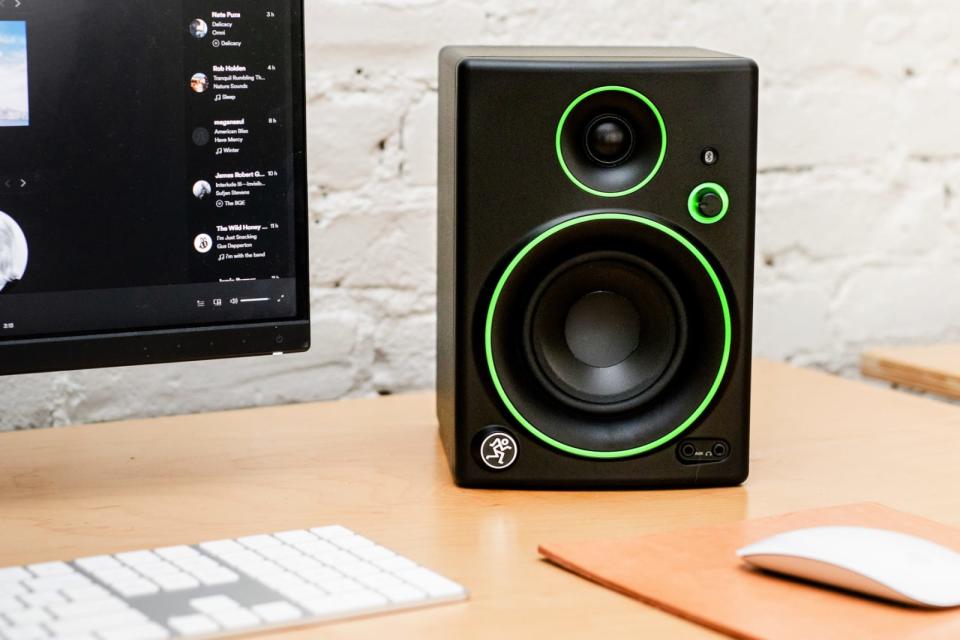
The Mackie CR4BT speakers sound better than anything else in their price range, have an easy-to-use design that doesn't take up too much space, and include Bluetooth to conveniently pair with mobile devices. Though you can find computer speakers that look and sound better, you'll have to spend a lot more to get substantially better performance than the CR4BT delivers.
All but one of our panelists felt that the Mackie CR4BT was the best-sounding 2.0 speaker system in our test; the lone dissenter ranked it second (we did not include the more expensive Audioengine HD3 in our blind listening test). The highs sounded crisp but not harsh, and bass notes were well defined, not muddy. Although some notes in the midrange (like male vocals) sounded a little muted, the CR4BT delivered a pleasant, balanced sound overall.
Achieving this balance is difficult for computer speakers, which often have very small woofers that are incapable of producing a lot of bass. The Mackie CR4BT model's 4-inch woofers help it perform better in the bass department but also make the speaker a little bit bigger than many of its competitors—but not so big that it takes up too much desk space. Each speaker is about as big as a rectangular box of tissues, if you stood it up on its side.
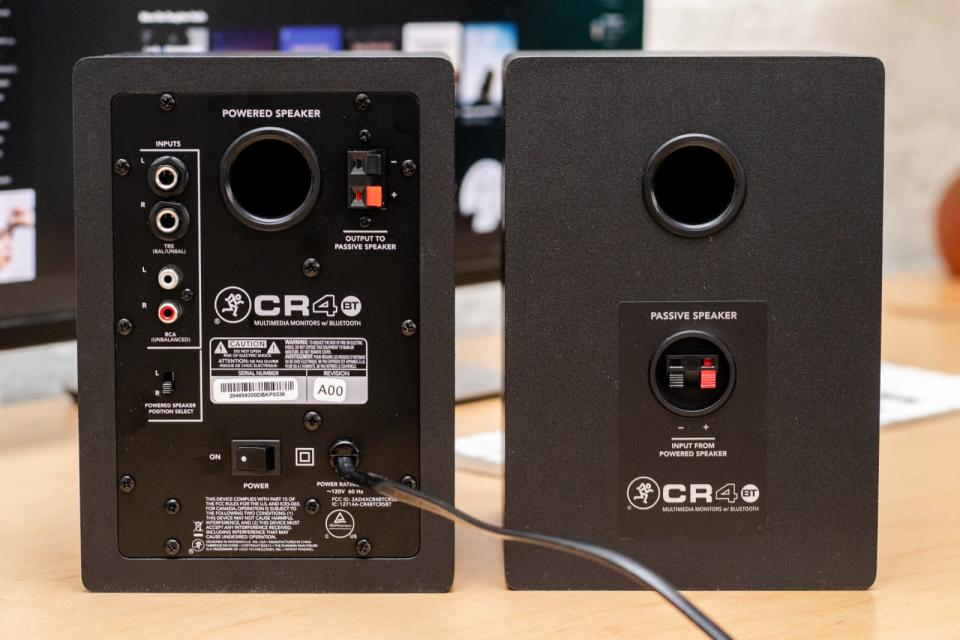
These speakers are easy to add to any existing setup. They have two rear inputs: an unbalanced RCA stereo input and a ¼-inch stereo input that accepts unbalanced (tip-sleeve) or balanced (tip-ring-sleeve) connections. In addition, one speaker features a ⅛-inch TRS aux input on the front, which allows you to easily plug in a temporary source without moving the speaker or having to blindly fumble around back searching for an input.
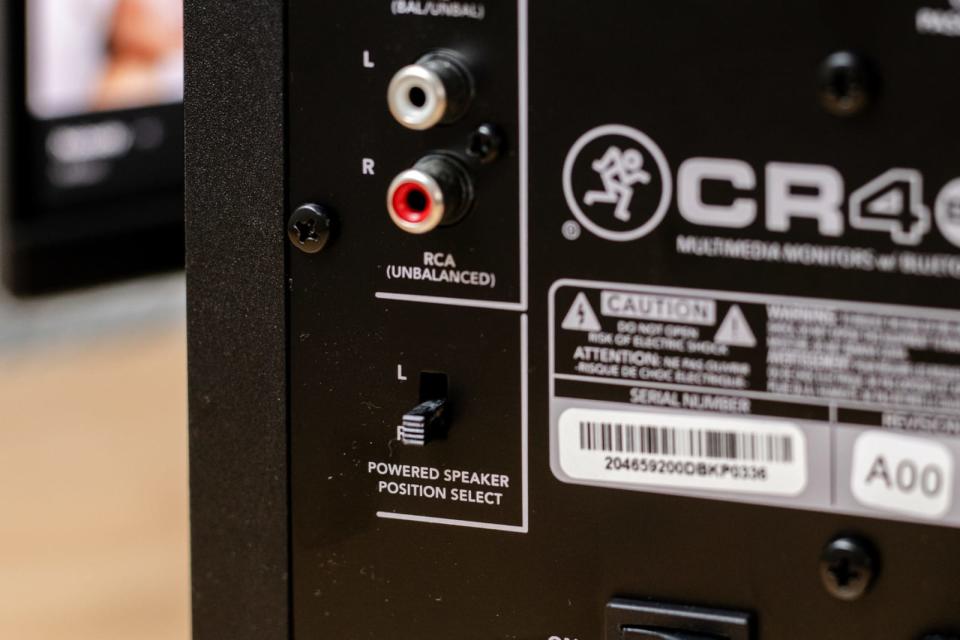
Next to the aux input is a ⅛-inch headphone-out jack that mutes the speakers when you plug in headphones. The logical placement of all of these inputs and outputs, as well as the volume knob on the front, make this system much easier to use throughout the day.
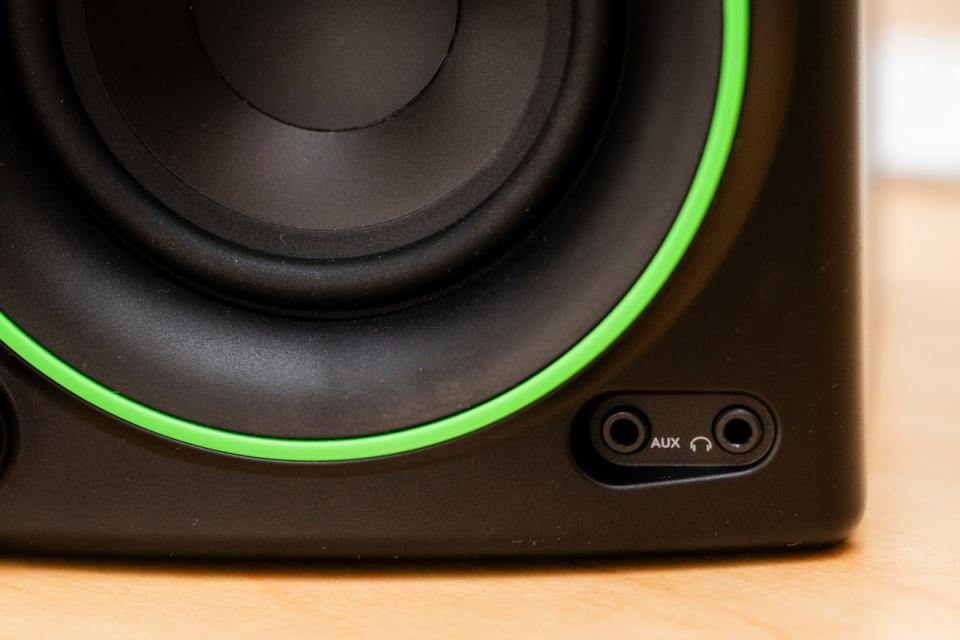
Speaking of the volume knob, although there's a power switch on the back of the speaker, you can also turn off the speakers by turning the volume knob fully counterclockwise until it clicks. We think this should be a feature on every computer speaker. The less you need to access the back of the speaker, the better. One last feature that helps with cable management is the inclusion of a switch that determines which speaker is left and which is right. This allows you to place the powered speaker on the side of the desk that is closest to your outlet and/or computer, minimizing the distance that the power and audio cables need to run.

You might not need your office speakers to have Bluetooth since you'll likely keep them plugged into your computer for the entirety of the workday, but the CR4BT has it anyways. We could hear a slight degradation in sound quality caused by the data compression used in Bluetooth, but it wasn't much of a distraction. Bluetooth-device pairing is quick, and you can easily reconnect a previously paired device by tapping the button on the front of the speaker.
Flaws but not dealbreakers
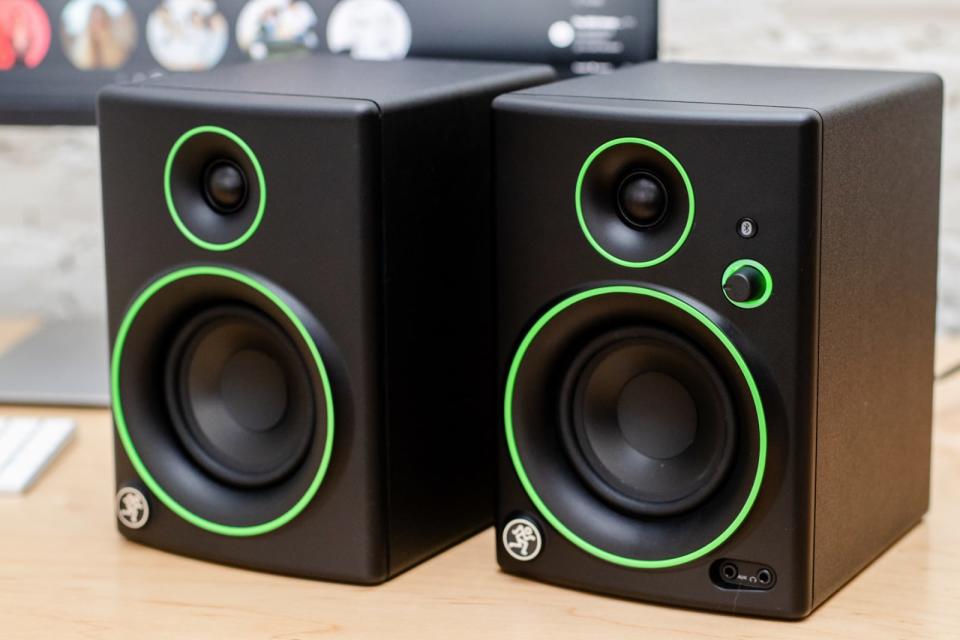
If you're constrained on desk space, the CR4BT might be a tad too big. We think that the 9-by-6-by-7½-inch speakers will work on most desktops, but if you need something smaller, consider the Audioengine HD3 or the Mackie CR3.
We weren't crazy about the neon green accents on the speaker's face. The CR3 is available with more soothing accent colors, including light blue and silver, and we wish the same were true for the CR4BT.
We appreciate the fact that the CR4BT has built-in Bluetooth but we noticed a quirk. Every time you turn on the speakers, they will connect to the previous two devices that were used. Being able to connect to two devices simultaneously is a nice feature, but we wish the system didn't do this automatically—if you forget to manually unpair the speakers from your phone, your ambient work music might be interrupted by the sound of a push notification. Additionally, the CR4BT offers only the basic SBC Bluetooth codec, which sounds pretty good but can't match the sound quality of newer codecs like aptX HD or LDAC, which sound closer to a wired connection because they carry a lot more audio data.
Budget pick: Mackie CR3
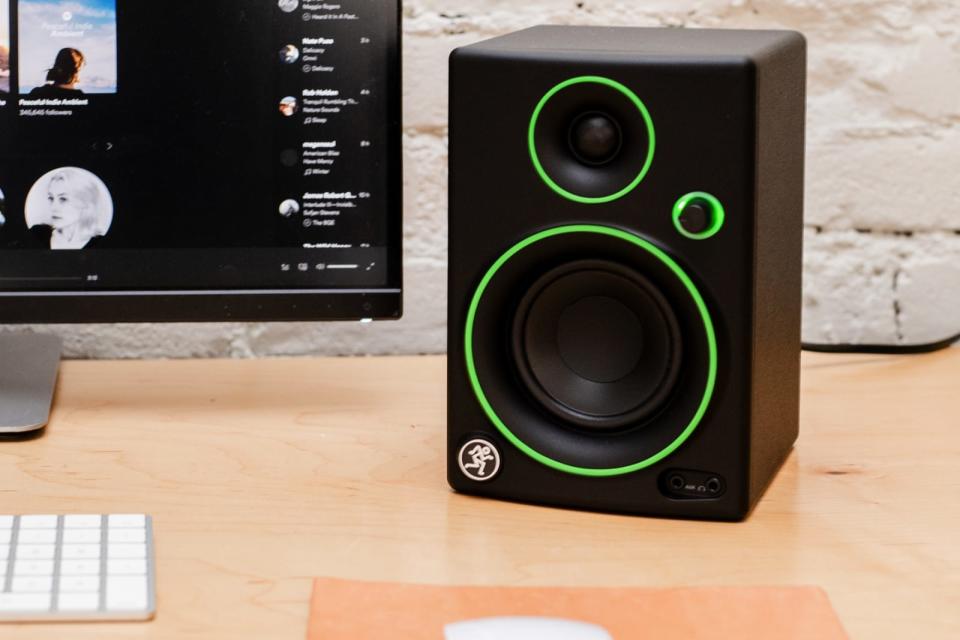
If you'd like to keep the price of your computer speakers around $100, or if you want something smaller than the Mackie CR4BT, consider the Mackie CR3 set instead. It has most of the same features as the CR4BT but it puts a smaller 3-inch woofer in a smaller cabinet. The CR3 still sounds quite good but it delivers less bass than the CR4BT. It also lacks Bluetooth, so it can't connect wirelessly to your mobile devices.

The CR3 speakers' smaller size (8 by 5½ by 6 inches) means that you should have no problem setting them up on your desk, even if it's crowded with knickknacks. And once you do, we think you'll be pleasantly surprised by their sound profile, which favors the midrange and vocals. In fact, a previous listening panel preferred the sound of the CR3 over the CR4BT and selected it as their top pick. However, our panel felt that although the CR3 speakers created nice open highs, their smaller woofer size limited the low end a little more than we preferred. You'll notice this most when listening to bass-heavy music like Kanye West's "Love Lockdown," which the speakers struggled to render accurately. But beyond that, the performance between the two Mackie sets is quite similar.
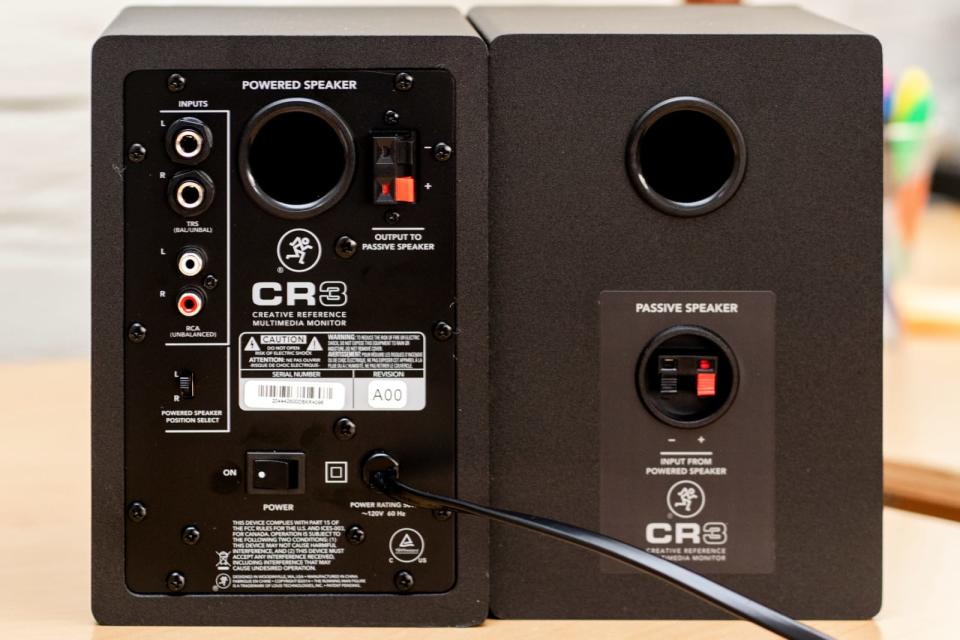
The CR3 has all of the same convenient features (minus the Bluetooth) that we appreciate about the CR4BT, including the same inputs and outputs, the front-panel volume knob and aux input, and the left/right speaker selection switch.
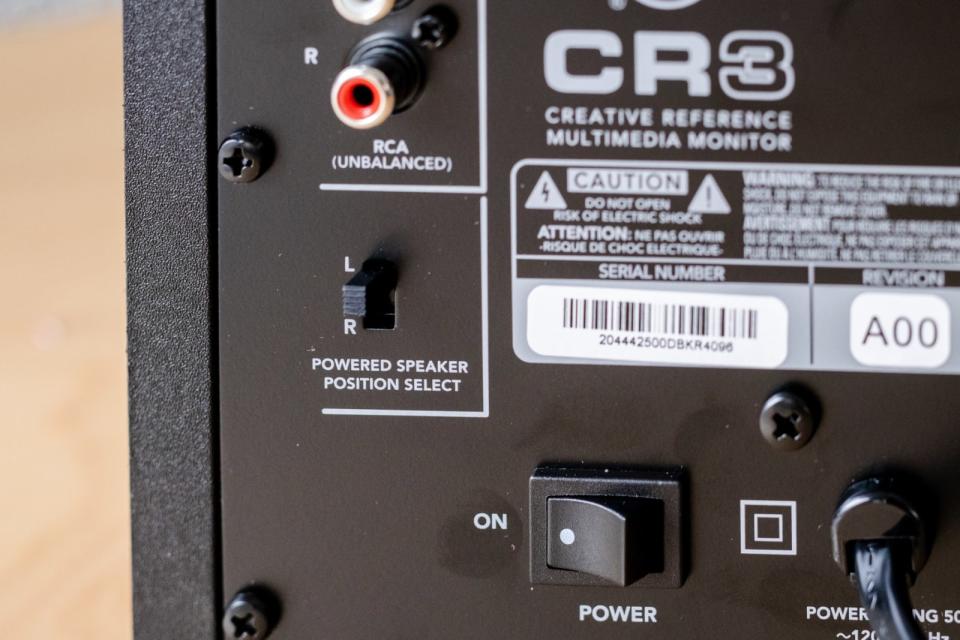
This makes the Mackie CR3 easy to add to your existing setup and use on an everyday basis. We found the green trim on our review sample to be distracting, but luckily the CR3 is available with more gentle accent colors, including light blue and silver.
Upgrade pick: Audioengine HD3
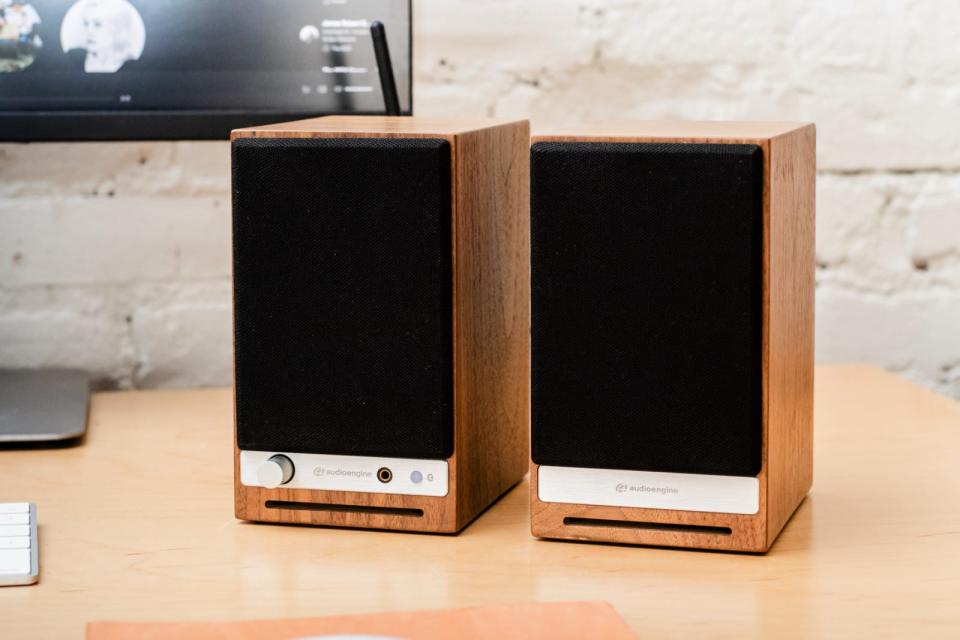
If you want a clear upgrade in performance and design, the Audioengine HD3 set has substantially better sound quality and a more elegant aesthetic than any speaker pair we tested—but it also costs a lot more. The HD3 has a petite footprint and includes connection options like USB and a subwoofer output that you won't find on many lower-priced computer speaker systems. It lacks a couple of the convenience features that the Mackie CR4BT offers, like the front-panel aux input and speaker-selector switch. But if pristine audio quality is your top priority, this is the pair to get.
We originally tested these speakers for our wireless powered bookshelf speakers guide, and they outperformed many larger bookshelf speakers. The HD3 speakers use smaller 2¾-inch woofers, yet because of the way the speakers are tuned, the reduced bass doesn't make them sound thin. We found that the system offered a really great balance between sounds across the frequency range. Tracy Chapman's "Fast Car"—which has a lot of little details that can get lost in less powerful, less balanced speakers—sounded as exciting through the HD3 as it did through the larger systems we considered. The HD3 doesn't play quite as loud as some other speakers we tested, like the Mackie CR4BT, but it's certainly loud enough to fill a bedroom or office.
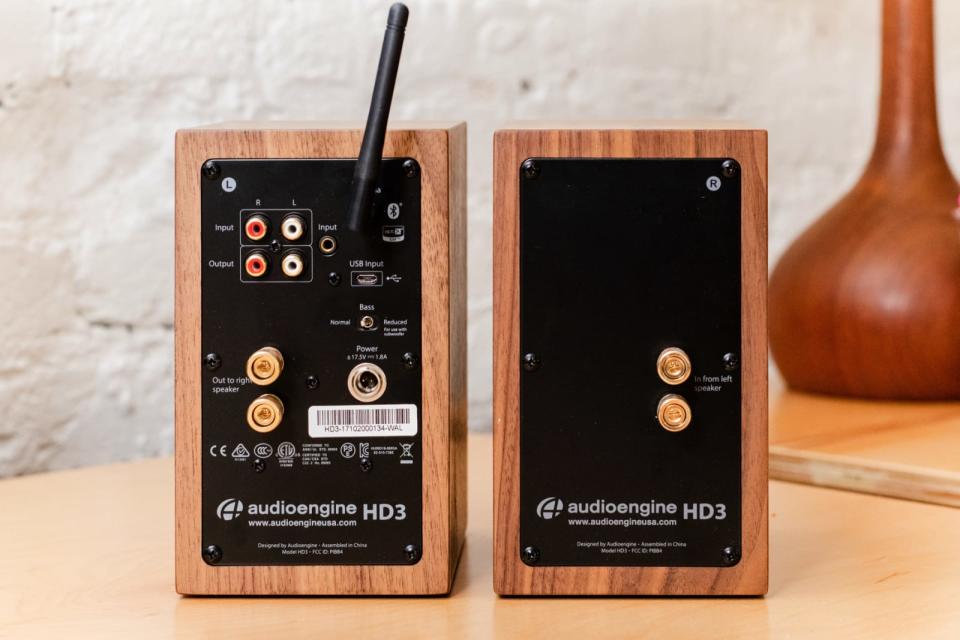
The system includes stereo RCA and 3.5 mm analog inputs (but no aux input on the front), plus a stereo RCA output and bass-reduction switch that makes it easy to connect an optional subwoofer. There's also a USB digital input for use with computers and smartphones; however, we are aware of a bug in the USB input that can cause you to lose the first second or two of sound (such as the ding of a notification) as the speakers come out of sleep mode. We did not experience this problem with our review sample, but a colleague who purchased the HD3 did. Audioengine is aware of the issue and is "actively investigating a way to eliminate this in future productions."
The HD3 includes aptX HD, an upgraded version of Bluetooth that Wirecutter staff writer Brent Butterworth, who initially tested this speaker, says offers a significant performance improvement over the standard SBC Bluetooth codec if you're using an aptX HD-compatible source; no variant of aptX has yet been made available for Apple iOS devices. It also includes AAC, a codec used by Apple iTunes and some streaming services; Apple phones and tablets are compatible with AAC, so this feature could deliver a slight improvement in sound quality for Apple fans.

The HD3 set's aesthetic is a vast improvement over that of the Mackie CR4BT and CR3. These compact speakers (7 by 5½ by 4¼ inches) have a very clean design, with a simple rectangular shape, a small metal accent plate, and no bombastic color accents. The system is available in four finishes (black, cherry, walnut, and white). Overall, the HD3 has an elegant neutrality, much like a black dress or well-fitting navy suit. It won't necessarily catch your eye, but when you see it you won't be able to take your eyes off it.
Also great: Klipsch ProMedia 2.1 THX

You probably don't need a subwoofer for home office use. (Has anyone ever thought that their conference call could use more bass?) But if you watch a lot of movies or play action-heavy video games through your computer system, the Klipsch ProMedia 2.1 THX system, which comes with a 6½-inch subwoofer, could enhance your experience. These speakers had the best sound quality of all of the 2.1 systems we tested, they have a very small on-desk footprint, and they don't feature any garish design elements. But the connection options are limited.
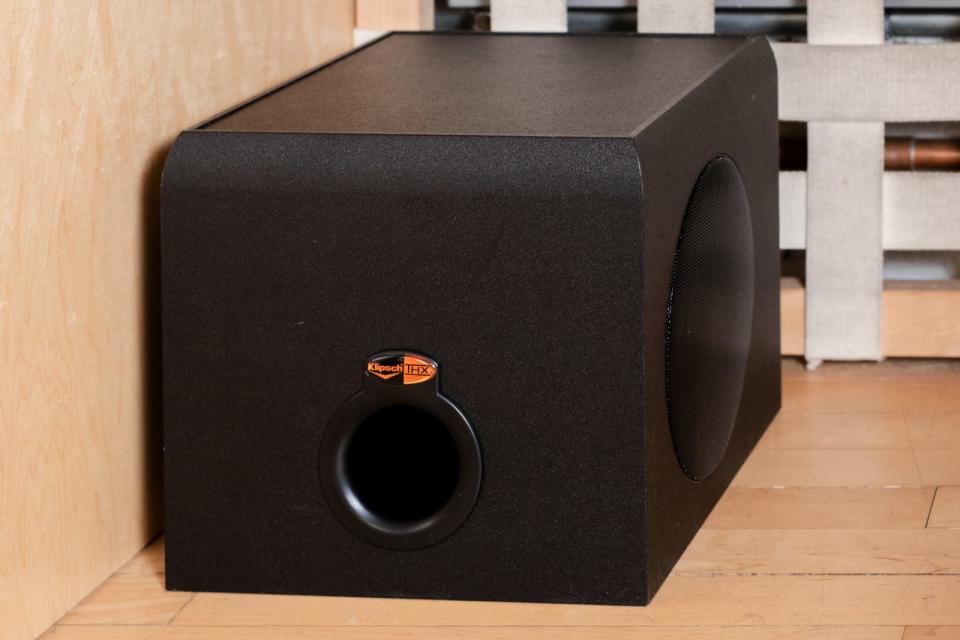
Many of the 2.1 systems we tested sounded great at the lower end but struggled to clearly render sounds in the middle and high end of the frequency range. The ProMedia 2.1 THX system did not have this problem. All of our panelists agreed that these speakers had a balanced, pleasing overall sound.

Will, the musician, referred to them as "warm." Klipsch wisely chose to put a subwoofer level control on the front of the left speaker, so you don't have to crawl underneath your desk to adjust the balance if it feels off. Once you've figured out that balance, the system sounds as good as the Mackie CR4BT and CR3 but it might take you a little time to dial in correctly.

The ProMedia 2.1 system doesn't have as many connection options as we'd like; in fact, it offers only a 3.5 mm mini-jack input and a headphone output, located on the side of the left speaker, and no Bluetooth. You can easily control the speaker's main volume from the small left speaker.
The competition
We called in the following models for our most recent round of testing:
Edifier R2000DB: Previous panelists thought that these speakers sounded much better than the Mackie CR4BT or Mackie CR3 and appreciated that they came in some nice finishes. But our panelists for this update found the high end of the frequency range to be a bit unpleasant. We also found that this speaker's design (which puts the volume and EQ control knobs around back) and size (about twice as big as the CR3) make it a worse option for everyday use at your desk.
Bose Companion 2 Series III: These speakers look like the platonic ideal of computer speakers—they're small, with a clean design and a front-panel volume control and aux input. Unfortunately, they don't sound great. The speakers struggle to produce really low frequencies, making bass-heavy songs like Kanye West's "Love Lockdown" sound less powerful.
Creative Pebble: We were curious as to whether these tiny speakers could produce enough bass to make them worth considering. Short answer: They cannot. The speakers made Tracy Chapman's "Fast Car" sound top-heavy and washed out.
Creative Sound BlasterX Kratos S3 and Sound BlasterX Kratos S5: Despite the fact that both of these systems come with subwoofers, we were underwhelmed by their bass capabilities. We also thought the speakers made higher frequencies, particularly female vocals, sound tinny. Unless you are willing to compromise on sound quality to get a system with gaming lights (only on the S5), you'd be better off with the Klipsch ProMedia 2.1 THX.
Edifier R980T: These speakers have a smaller footprint than some other Edifier speakers we tested and are cheaper than the Mackie CR3, but none of our panelists thought they sounded good enough to recommend. Plus, like other Edifier speakers, the volume and EQ adjustment dials are on the back of the speaker, which makes them harder to use as computer speakers. The company compensates for this with the inclusion of a small remote, but we find that tiny remotes are too easy to lose.
Edifier R1700BT: These speakers have similar usability issues as the other Edifier speakers we tested. The volume and EQ adjustment dials are on the side of one of the speakers rather than on the front (which would make them easier to access) or the back (which would make them harder to access). We found that these speakers sounded worse than the Mackie CR4BT, particularly in the middle part of the frequency range.
Harman Kardon Soundsticks III: These speakers have a design that makes them worthy of inclusion in the Museum of Modern Art's collection, but all of our panelists felt they sounded unbalanced compared with the Klipsch ProMedia 2.1, although it was close. The system places the dial for adjusting the subwoofer level on the subwoofer itself, which means that when you want to turn down the sub, you have to get out of your chair and crawl underneath your desk. You'll also have to do this if you want to turn off the system (and its very bright lights), because the on/off switch is right next to the aforementioned subwoofer control.
We tested the following models for previous versions of this guide:
The Logitech Z625 model is a THX-certified 2.1 system and delivered more bass than most of the speakers we tested. The top could be a bit strident at times but not enough that it turned us away. If you're looking for a bass-heavy system that has an optical digital audio connection for under $200, this is definitely worth a listen.
The PreSonus Eris 4.5 system's low end was a little muddy, and the mids were a bit muted. There are controls on the back to adjust the frequency bands, so you might be able to fine-tune the sound more to your liking. But this set is double the price of the Mackie CR3.
The Samson MediaOne BT3 is one of the few stereo computer speaker systems under $100 that has Bluetooth. Its sound, though, is very muffled, and the mids sound a bit forward, like cupping your hands around your mouth.
The JBL Jembe is another pair of sub-$100 Bluetooth speakers. We liked the sound for the price, as long as the volume wasn't up too high—otherwise the bass fluttered, and the highs were tizzy. Also, its Bluetooth connection was unreliable.
We brought in the Micca PB42X speakers after reading some favorable reviews. Unfortunately, we found that the bottom end produced extreme port noise. There was also a big midrange peak that added a twang to the sound. Our sample also had the left and right channels reversed.
After having the M-Audio AV40 as a previous top pick, we had high hopes for the company's AV42 model. We were disappointed. One panelist called the excessive bass "ridiculous," and another said it "obscures everything else."
We used the Audioengine A2+ speakers as a comparison standard for our testing. They sound great, but unlike the somewhat similar Audioengine HD3 they're not really tuned to compensate for their lack of bass.
This guide may have been updated by Wirecutter. To see the current recommendation, please go here.
When readers choose to buy Wirecutter's independently chosen editorial picks, Wirecutter and Engadget may earn affiliate commissions.
